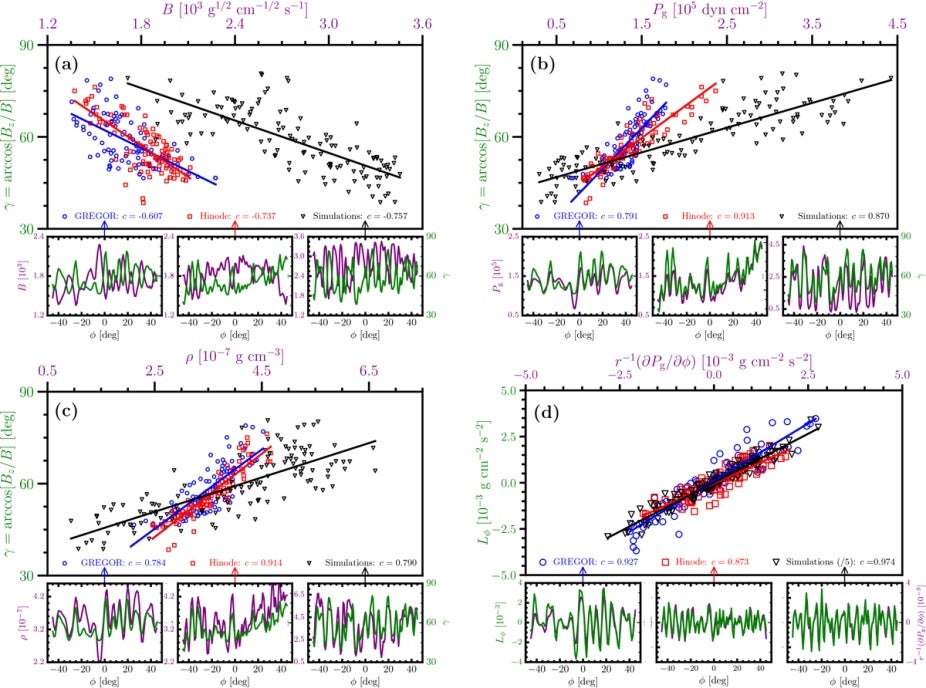
Scatter plots of the physical quantities in penumbra (extracted along an azimuthal arc) for GREGOR data (red squares), Hinode data (blue circles), and the MHD simulation (black triangles). Pearson correlations coefficients, c, for each of these pieces of data are provided in the legend. Linear fits to the data are shown with thick solid color lines. Upper left: γ − ∥B∥. Upper right: γ − Pg. Lower left: γ − ρ. Lower right: Lϕ − r−1∂Pg/∂ϕ. Each panel also includes three smaller subpanels in which the variations in the physical quantities along ϕ are displayed in purple and green colors. These subpanels are ordered as: GREGOR (left), Hinode (middle), and MHD simulations (right). This is also indicated by the arrows under the correlation coefficients for each data source. We note that the values of the ϕ components of the Lorentz force and of the gas pressure gradient in the simulations have been divided by five. The results demonstrate that, in the azimuthal ϕ direction, penumbral spines and intraspines are in almost perfect magnetohydrostatic equilibrium between the azimuthal components of Lorentz and pressure forces.
Astronomy & Astrophysics: Sunspots survive on the solar surface for timescales ranging from days to months. This requires them to be in an equilibrium involving magnetic fields and hydrodynamic forces. Unfortunately, theoretical models of sunspot equilibrium are very simplified as they assume that spots are static and possess a self-similar and axially symmetric magnetic field. These assumptions neglect the role of small-scale variations of the magnetic field along the azimuthal direction produced by umbral dots, light bridges, penumbral filaments, and so forth. Aims. We aim to study whether sunspot equilibrium is maintained once azimuthal fluctuations in the magnetic field, produced by the sunspot fine structure, are taken into account. Methods. We apply the FIRTEZ Stokes inversion code to spectropolarimetric observations to infer the magnetic and thermodynamic parameters in two sunspots located at the disk center and observed with two different instruments: one observed from the ground with the 1.5-meter German GREGOR Telescope and another with the Japanese spacecraft Hinode. We compare our results with three-dimensional radiative magnetohydrodynamic simulations of a sunspot carried out with the MuRAM code. Results. We infer clear variations in the gas pressure and density of the plasma directly related to fluctuations in the Lorentz force and associated with the filamentary structure in the penumbra. Similar results are obtained in the umbra despite its lack of an observed filamentary structure. Results from the two observed sunspots are in excellent qualitative and quantitative agreement with the numerical simulations. Conclusions. Our results indicate that the magnetic topology of sunspots along the azimuthal direction is very close to magnetohydrostatic equilibrium, thereby helping to explain why sunspots are such long-lived structures capable of surviving on the solar surface for days or even full solar rotations.